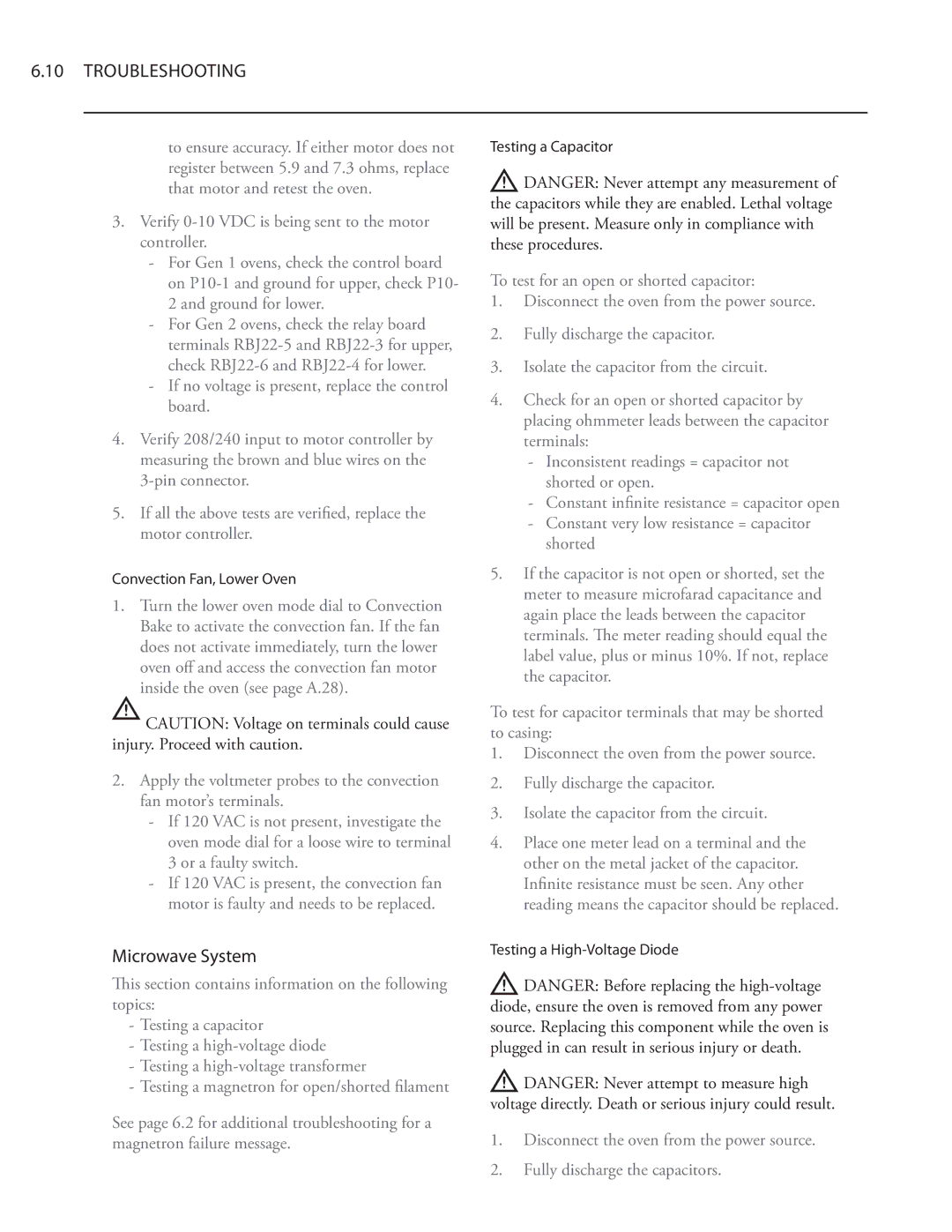
6.10TROUBLESHOOTING
to ensure accuracy. If either motor does not register between 5.9 and 7.3 ohms, replace that motor and retest the oven.
3.Verify
-For Gen 1 ovens, check the control board on
-For Gen 2 ovens, check the relay board terminals
-If no voltage is present, replace the control board.
4.Verify 208/240 input to motor controller by measuring the brown and blue wires on the
5.If all the above tests are verified, replace the motor controller.
Convection Fan, Lower Oven
1.Turn the lower oven mode dial to Convection Bake to activate the convection fan. If the fan does not activate immediately, turn the lower oven off and access the convection fan motor inside the oven (see page A.28).
CAUTION: Voltage on terminals could cause injury. Proceed with caution.
2.Apply the voltmeter probes to the convection fan motor’s terminals.
-If 120 VAC is not present, investigate the oven mode dial for a loose wire to terminal 3 or a faulty switch.
-If 120 VAC is present, the convection fan motor is faulty and needs to be replaced.
Microwave System
This section contains information on the following topics:
-Testing a capacitor
-Testing a
-Testing a
-Testing a magnetron for open/shorted filament
See page 6.2 for additional troubleshooting for a magnetron failure message.
Testing a Capacitor
![]() DANGER: Never attempt any measurement of the capacitors while they are enabled. Lethal voltage will be present. Measure only in compliance with these procedures.
DANGER: Never attempt any measurement of the capacitors while they are enabled. Lethal voltage will be present. Measure only in compliance with these procedures.
To test for an open or shorted capacitor:
1.Disconnect the oven from the power source.
2.Fully discharge the capacitor.
3.Isolate the capacitor from the circuit.
4.Check for an open or shorted capacitor by placing ohmmeter leads between the capacitor terminals:
-Inconsistent readings = capacitor not shorted or open.
-Constant infinite resistance = capacitor open
-Constant very low resistance = capacitor shorted
5.If the capacitor is not open or shorted, set the meter to measure microfarad capacitance and again place the leads between the capacitor terminals. The meter reading should equal the label value, plus or minus 10%. If not, replace the capacitor.
To test for capacitor terminals that may be shorted to casing:
1.Disconnect the oven from the power source.
2.Fully discharge the capacitor.
3.Isolate the capacitor from the circuit.
4.Place one meter lead on a terminal and the other on the metal jacket of the capacitor. Infinite resistance must be seen. Any other reading means the capacitor should be replaced.
Testing a
![]() DANGER: Before replacing the
DANGER: Before replacing the
![]() DANGER: Never attempt to measure high voltage directly. Death or serious injury could result.
DANGER: Never attempt to measure high voltage directly. Death or serious injury could result.
1.Disconnect the oven from the power source.
2.Fully discharge the capacitors.
